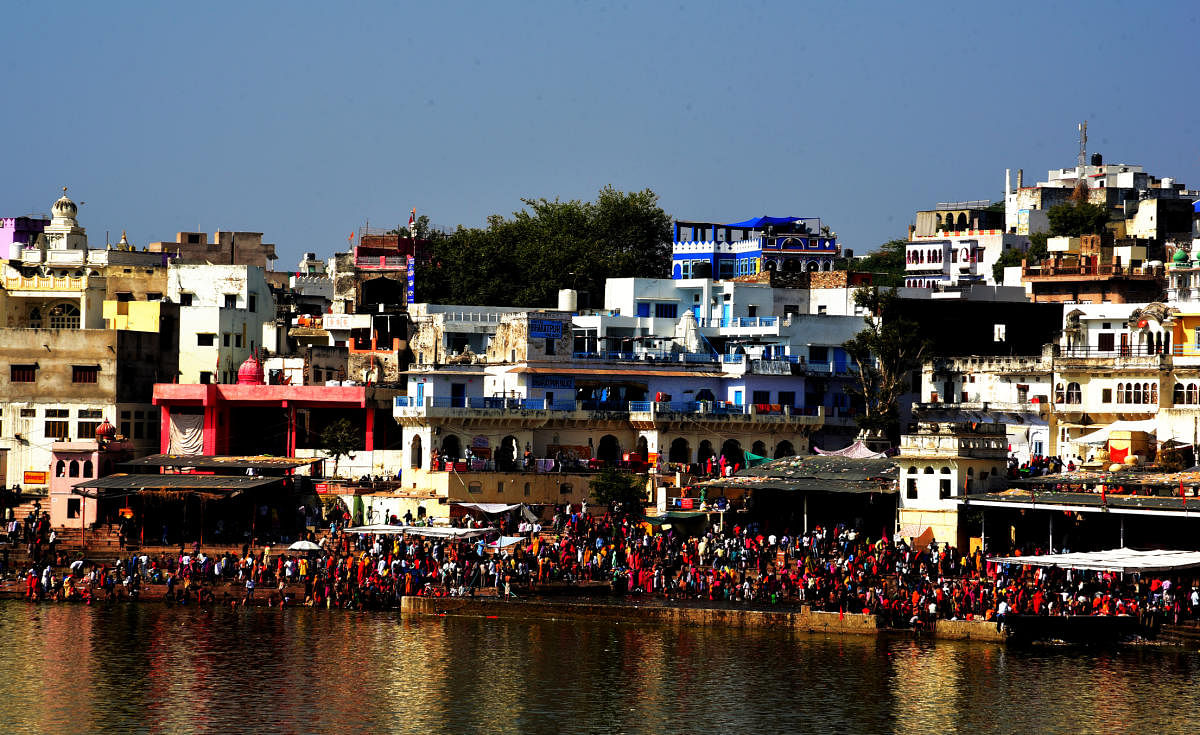
Widely reported as the world’s largest gathering of camels, the Pushkar fair is truly a mood booster. A visit to the fair leaves one with a treasure trove of memories and little trinkets of many emotions.
My last visit to Pushkar was memorable. From pleasant coffee and conversations with friends who had already visited the largest desert affair, my imagination had led me to a visual of a small town in Rajasthan with signature narrow lanes, dotted with many temples, and bhoongas (local huts) on the outskirts of the town even before I actually landed.
A comfortable overnight train journey brought me to Ajmer junction from Mumbai. I took a taxi to the hotel I had made prior bookings with. The hotel was close to Brahma Temple and Pushkar Lake, the fair hub. A hearty brunch of flattened bread, locally called rotla, with a hot cup of chai made of camel milk did much good. Approaching the venue of the fair, I could see a cloud of dust in pockets, lit up by the early winter light. The camels were strolling freely on the sandy soil. A bit closer, the bright turban adorning faces of Rajasthani men became noticeable. Huddled in a motley group of twos and threes, these men had high hopes of a good sale of the livestock they had brought in here from the remotest part of Rajasthan. Some of them were even third generation traders.
Local flavour
My intent was to chat up with these desert people, to know their real stories, beyond the fair, and get a sense of their nomadic lives as closely as I could. Gathered in hundreds, these traditional herders and nomads offered a rare picture of unity.
This was my up-close experience of observing nomadic pastoral life and the age-old trade of camels. After strolling around for nearly two hours, I got to interact with a middle-aged herder who had once visited Jaipur and knew a bit of Hindi and sporadic words of English including the quintessential, thank you. Bhanwar Singh was friendly enough to start a conversation, however, we decided to meet for longer hours during my stay. The morning walks along Pushkar Lake the next few days, undoubtedly conveyed the sense of reverence and faith. As mythology says, Lord Brahma had dropped a lotus in the Pushkar Lake. This reference in the Hindu texts had made this desert a ‘holy’ oasis. The reverence had grown stronger over centuries to remain unwavering till date, as thousands were taking holy dips during this Hindu calendar time of Karthik Purnima (full moon).
Every day of my stay I did walk back through the camping site enveloped in a hazy winter light slowly revealing characters as they emerged from their tents about to start their day with errands, a smoke from the hookah, a round of chai along with animated conversations amongst themselves as they sat outside the tents. The animals started to move their limbs too as if copying their owners; the magnificent golden light bathed the surroundings making it all seem ethereal.
Earthy conversations
Years of travel has taught me a valuable lesson, talk to people to know them and their stories before you aim cameras at them. Soon it was my time with Bhanwar Singh!
Bhanwar Singh, a 47-year-old herder from Alwar district, had been coming with his family to sell his livestock at the fair. The clearly perceptible lines on his rugged face made him seem much older than his actual age. He called out to his wife Gulabo to get a cup of chai for me, as I happily sat alongside his two grandchildren, aged six, revelling in their dusty hands and feet.
His gaze shifts towards the tents and without being asked says, “I used to accompany my father and uncle to this fair as a boy, so many memories of my younger days are connected with the mela. Those days it was just the people of Rajasthan, mostly from nearby villages, towns who would come over to buy camels. It’s only since the past decade or so that the footfall of visitors from the other parts of India has become so huge; supplemented by the tourists from around the world. We initially did not understand much about their being so gung-ho about the mela, but over the years we have realised that these are mainly city dwellers for whom meeting us, the nomads, and seeing the livestock so close is a unique experience.”
He pauses and adds, “It looks much more colourful now. I have even heard that some biggies from the Bombay films also come but I am not familiar with any names of current singers,” he adds. For the fun-loving and gregarious traveller, there is much more. I did see many travellers trying their strength at a game of tug-of-war, even if briefly! Some very unusual contests kept happening at the festival; the longest moustache competition being probably the biggest crowd-puller! If you have not visited the Pushkar fair yet, then you should in the next edition.